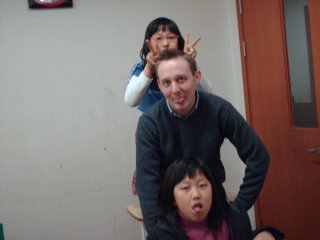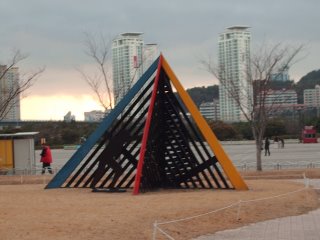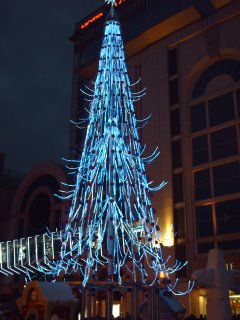National Flavor
To get an idea of the place of high esteem that kimchi holds in Korea, just ask a Korean. During one of our weekly interviews at the school about food, many of my students espoused the many virtues of kimchi, which was cited as "the best Korean food" by the majority of my students. They are very proud in their belief that kimchi is recognizable as Korean all around the world. In addition, they believe strongly in the health properties of kimchi. To hear some tell it, one would think that kimchi is a miracle cure-all, fixing everything from the common cold to constipation to SARS and avian influenza. While the latter claims may be exaggerations, it is true that kimchi is a healthy food. Red chilies are rich in vitamins A, B and C, and the curative qualities of garlic and ginger (which also go into the mix) are well-documented. However, there are some who theorize that excessive consumption may lead to stomach cancer, and may explain the relatively high rate of stomach cancer among Koreans (although others believe it may be the glutinous rice that is favored by Koreans that may be to blame).
I had sampled kimchi a few times in my life before arriving in Korea, but now I have truly found a love for it (although my favorite is the mu variety, made from radish, not baechu). I usually buy a quarter-cabbage from the local Cheonsang "Top Mart" on a semi-weekly basis. The Korean cookbook I brought with me from the States has a recipe for baechu kimchi, and I had always been tempted to try my hand at it. Finally, at Jessica's urging, I decided to give a try this weekend. I bought a new food processor at E-Mart, a special clay kimchi pot in Seongnamdong, and rounded up the rest of the necessary ingredients. After letting the cabbage halves soak in salted water all day, I prepared the pepper mixture, spread it between the leaves of cabbage and placed it in the pot out on the balcony to ferment for three days, Last night, it was finally ready. The final verdict: it tastes like kimchi, but it is much, much too salty (somewhere along the line, I added too much salt).


I am going to Seoul tomorrow for the New Year's holiday, so I will not be updating for a few days (not that I update that regularly or frequently anyway). But that brings me to my favorite Korean news article of the past week; sounds like a good idea and easy money for some.
Last but not least, R.I.P. James "Godfather of Soul" Brown, you will be sorely missed.














